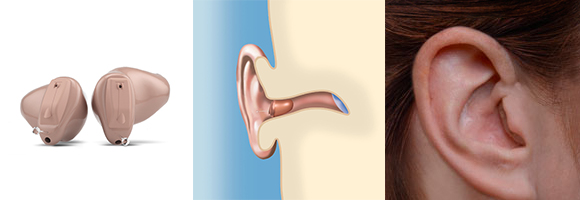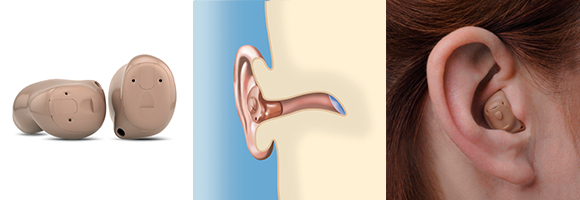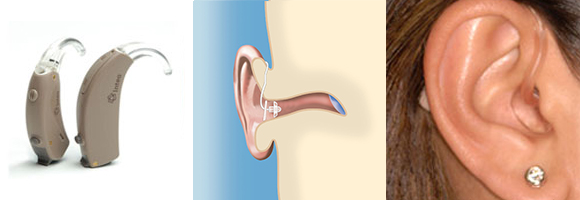HEARING DEVICES
Several models of hearing aids are available to help you hear better. Here is an overview:
“Invisible” models
Micro RIC and RIA
Characteristics
- Discrete and comfortable
- Micro-receiver concealed behind the ear
- Invisible and transparent wire or tube
- No blocked-ear sensations
- Mainly designed for high-frequency hearing losses

*An evaluation by an audioprosthetist is required to determine if this model is best for you.
Peritympanic
Characteristics
- Nearly invisible and comfortable
- Fits entirely into the hearing canal
- Excellent sound quality
- Mainly designed for slight to moderate hearing loss
- *An evaluation by an audioprosthetist is required to determine if this model is best for you.
Classic models
Full-shell or half-shell in-the-ear (ITE)
Characteristics
- More apparent than “invisible” models, but just as comfortable
- Fits into the bowl-shaped area of the outer ear
- Designed for slight to severe hearing loss
- Ergonomic for people with dexterity problems

*An evaluation by an audioprosthetist is required to determine if this model is best for you.
Contour
Characteristics
- More apparent than “invisible” models, but just as comfortable
- Inserted behind the ear
- Requires a customized earmold
- Designed for slight to severe hearing loss
- Ergonomic for people with dexterity problems

*An evaluation by an audioprosthetist is required to determine if this model is best for you.
Other characteristics
In addition to the characteristics listed above, modern hearing aids offer the following technical characteristics:
Automatic volume control
- Sophisticated system that adjusts your hearing aid's volume without any intervention on your part
Adaptive directional microphone
- Technical characteristic that zones in on sound reception from a given direction. For example, if a sound comes from your right side, the device will focus on this direction and automatically improve the signal/noise ratio.
Reduction of ambient sound
- Technical process that filters signals and makes them easier and more comfortable to hear
Active feedback suppression (whistling)
- Complex process that prevents and eliminates the sound of whistling in real time
Speech amplification
- Process whereby the integrated circuit of your hearing device identifies and focuses on signal segments that sound like speech
Attenuation of impact noises
- Acoustic smoothing of brief and intense sounds such as the closing of dresser drawers or clanging dishes
Usage log
- This device is equivalent to an airplane's black box. It allows the audioprosthetists to gather and analyze statistical data through your hearing aid's integrated circuit in order to refine its technical settings.
Options available
Hearing aids use digital technology that comes in a range of sound qualities. To decide on the one that's best for you, you must take your lifestyle and hearing expectations into account.
Optimal
- You want only the best on the market.
- Communication is of the utmost important for your professional and social life.
- You lead an active lifestyle (outings, restaurants, cinema, sports, music lover, etc.).
- Cost: $$$
Intermediate
- Communication is very important for your professional and social life.
- You are active (outings, restaurants, cinema, sports, etc.).
- Cost: $$
Basic
- You lead a calm lifestyle.
- You don't often find yourself in places and environments with different sound profiles over the course of a regular day.
- Cost: $


